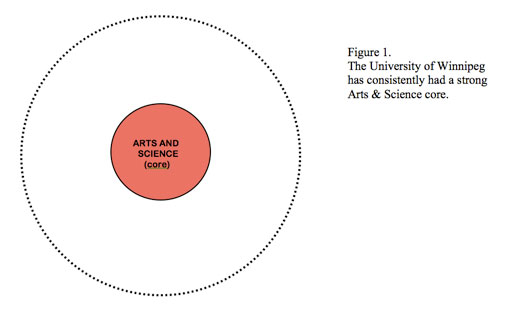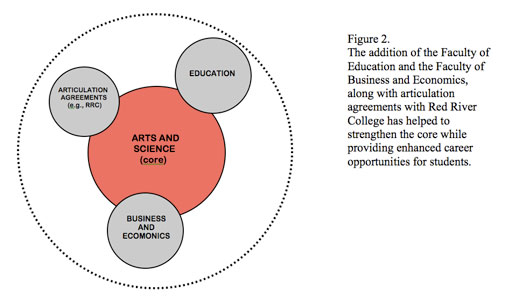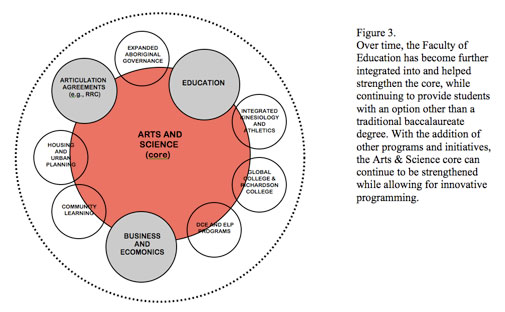|
Heather Milne
PART ONE: THE VISION, MISSION, AND VALUES TC "PART ONE: THE VISION, MISSION, AND VALUES" \f C \l "1"
The Vision
In his State of the University address given at the University’s 40th Anniversary Homecoming celebration in 2007, President Axworthy described a strategy for responding to change. It was described as “a traditional way of going forward.” This University, like all of the inhabitants of our planet, must recognize the role of sustainability in this century. Statements from this address have been incorporated into the University’s planning process as a restatement of the University’s vision.
“The University of Winnipeg will model sustainability in a way that will help everyone who sets foot in our institution see what a sustainable future will look like. All four dimensions of sustainability (ecological, economic, social, and cultural) must be central to The University of Winnipeg. Sustainability must define the way we operate, the way we educate, the way we conduct research, and the way we interact with the neighbourhood community in which this institution resides.”
This vision describes a University that is part of, and contributes to, the community in which it resides. Our activities shape the environment, provide opportunities to the citizens of the inner city, and enhance the economic viability of downtown Winnipeg. Our research contributes to social knowledge and our graduates contribute to society in multiple ways for decades after they leave The University of Winnipeg. Sustainability is the paradigm that connects learning with access, economic viability, community interaction, and social commitment. This vision highlights the importance of the University’s interactions with the neighbourhood community. One of the outcomes described later in the plan specifically focuses on community learning as the means by which the University and the community are linked.
The Mission
The University of Winnipeg’s mission statement underscores the liberal arts and sciences roots of the University of Winnipeg. There are four major components to the mission statement. The first is a statement of its mandate. In the two decades since this document was written the University has added a major continuing education program and two new degrees. This section, with proposed amendments, is shown below.
“The University of Winnipeg is committed to excellence in post-secondary education through undergraduate, selected graduate and continuing education programs, rooted in the liberal arts and culminating in degrees such as those in Arts, Science, Education, Theology, Family Therapy, and Business and Economics.”
In the second part the University acknowledges the tension between the two dominant values that define the University. First is the tension between University and College. Second is the tension between access and excellence. In both instances the University strives to achieve both. The University of Winnipeg defines itself as an institution that offers a superior university education within the intimate atmosphere of a college as well as access with academic excellence. This choice is defined by its history, incorporated within its culture, and honored in its plans. The University of Winnipeg received its charter in 1967 but its roots date back more than 130 years. The founding colleges were Manitoba College (1871) and Wesley College (1888), which merged to form United College in 1938. This experience has permeated the University’s culture and placed an expectation on the faculty and staff that education does not end in the classroom.
“[O]ur primary responsibility is to our students, to whom we strive to offer a community which appreciates, fosters and promotes values of human dignity, equality, non-discrimination, and diversity. We view both accessibility and excellence as important goals, and will endeavour to make the University as accessible as we can while maintaining high standards of quality in our academic programs”
Third, the mission statement describes what it imparts to its students, which are in line with a liberal arts education.
“We provide students with breadth and depth of knowledge, the skills to communicate effectively and to make informed decisions, an understanding of the ethical problems facing our society and an appreciation of the full range of human, aesthetic and environmental values.”
Finally it describes the core academic values.
“The University of Winnipeg values academic freedom, self-governance, and community service.”
The Values
The Mission Statement describes many of the academic values essential to the University. The University of Winnipeg’s 2004 Strategic Plan expands on this with a list of values that guide the University’s actions.
“We acknowledge that society needs skilled, knowledgeable graduates prepared for work, citizenship, and a fulfilling personal life. We believe in the importance of fostering our students’ intellectual capacities, ethical and civic responsibilities, and involving them in the discovery and development of new knowledge.
“We believe that our operations and systems must be aligned with our mission. We will foster a culture of open communication, shared responsibility and collective governance, so that all members of the University community will have a say and stake in our future success.
“A well-designed University has the capacity to respond to local and immediate conditions, but has a strategic approach to planning, so that decisions about hiring, programming and the allocation of resources are not driven by contingencies, but informed by careful considerations for the long-term productivity and prosperity of the institution.
“Above all we value what makes this University distinctive: its history of excellence and social consciousness; its student body, drawn from a diverse population of ethnicities, income levels, ages and cultures; and its belief that a liberal education, when taught in an exacting, creative and humane way, can have transforming effects on individual lives and on society as a whole.”
PART FOUR: 2009 ACADEMIC RENEWAL EXERCISE TC "PART FOUR: 2009 ACADEMIC RENEWAL EXERCISE" \f C \l "1"
Academic renewal is an ongoing process at any post-secondary institution. Much of the Senate’s governance activities are concerned with the results of this renewal, of which new courses and new programs are the most obvious. The process for review and updating the University’s Academic Plan began in 2007. As a result of the early work on the plan, it became clear that Academic Renewal must be at the centre of the process for updating the Academic Plan. Therefore, the work on the update was held in abeyance until the University underwent a broader and more specific exercise around the notion of Academic Renewal. From January to April 2009, The University of Winnipeg engaged in an Academic Renewal exercise to gain faculty, staff, and student insight into how the University can best serve the diverse and changing needs of our students. Focus group and working group sessions were held with students, staff, faculty, and members of the surrounding community. The results of this exercise were reviewed by the Academic Renewal Policy Committee (see Appendix B for the membership of this committee) and are incorporated into this academic plan. Summary documents are included as appendices.
The Academic Renewal framework included three key elements. First was the importance of the five primary outcome statements described above. Second was the recognition that Academic Renewal is ongoing and is directly involved with the Academic Plan. Third was the framework for renewal. The Liberal Arts and Sciences are at the core of the University’s mission. Professional programs are not separate stand-alone processes. They are linked to and flow from the liberal arts core. The following diagrams were used to describe the conceptual framework for Academic Renewal.



Six themes emerged from the first stage of the Academic Renewal exercise (see Appendix C). Drawing from these themes, eleven working group sessions of staff and faculty were held during the second stage with the goal of identifying broad themes and principles, proposing process and framework for the development of new initiatives, and to suggest initiatives in support of academic programming (see Appendix D). Common themes, principles, frameworks, and processes have been incorporated into the 2009 Academic Plan update.
The scope of the Academic Plan is broad, and initiatives are not prioritized nor are responsibilities assigned. This is deliberate. The plan provides the framework and the context for where we want to go over the next five years. While the ideas for how we can achieve this came from a number of sources, the decisions about how to achieve this, where to place the priorities, and what financial and human resources are to be applied, cannot be done in a broad conceptual paper. These are decisions to be made at multiple levels that must include the departments. They must be based on a real understanding of resources and resource requirements. They cannot be separated from the analysis of degree requirements and must be informed by a clear understanding of financial requirements. In other words, the broad planning must be consistent with the departmental planning and the budget. In Fall 2009, the integrated budgeting and planning process will begin at the department level. Its purpose will be to provide a bridge between long-term general planning and annual budgeting. Specific projects and initiatives will be developed and prioritized. Budgets will be developed over 3 to 5 years. Department plans will be incorporated into the budget planning process. Ideas generated from this will also infuse the annual process for reviewing and updating the Academic Plan.
PAGE
PAGE 1
Figure 1.
The University of Winnipeg has consistently had a strong Arts & Science core.
ARTS AND
SCIENCE
(core)
Figure 2.
The addition of the Faculty of Education and the Faculty of Business and Economics, along with articulation agreements with Red River College has helped to strengthen the core while providing enhanced career opportunities for students.
ARTS AND
SCIENCE
(core)
EDUCATION
BUSINESS AND ECOMONICS
ARTICULATION
AGREEMENTS
(e.g., RRC)
Figure 3.
Over time, the Faculty of Education has become further integrated into and helped strengthen the core, while continuing to provide students with an option other than a traditional baccalaureate degree. With the addition of other programs and initiatives, the Arts & Science core can continue to be strengthened while allowing for innovative programming.
ARTS AND
SCIENCE
(core)
EDUCATION
ARTICULATION
AGREEMENTS
(e.g., RRC)
EXPANDED
ABORIGINAL
GOVERNANCE
HOUSING
AND
URBAN
PLANNING
COMMUNITY
LEARNING
GLOBAL COLLEGE & RICHARDSON COLLEGE
INTEGRATED KINESIOLOGY
AND
ATHLETICS
DCE AND ELP
PROGRAMS
BUSINESS AND ECOMONICS
|